The AMD Radeon R9 Nano Review: The Power of Size
by Ryan Smith on September 10, 2015 8:00 AM ESTCompute
Shifting gears, we have our look at compute performance.
Starting us off for our look at compute is LuxMark3.0, the latest version of the official benchmark of LuxRender 2.0. LuxRender’s GPU-accelerated rendering mode is an OpenCL based ray tracer that forms a part of the larger LuxRender suite. Ray tracing has become a stronghold for GPUs in recent years as ray tracing maps well to GPU pipelines, allowing artists to render scenes much more quickly than with CPUs alone.
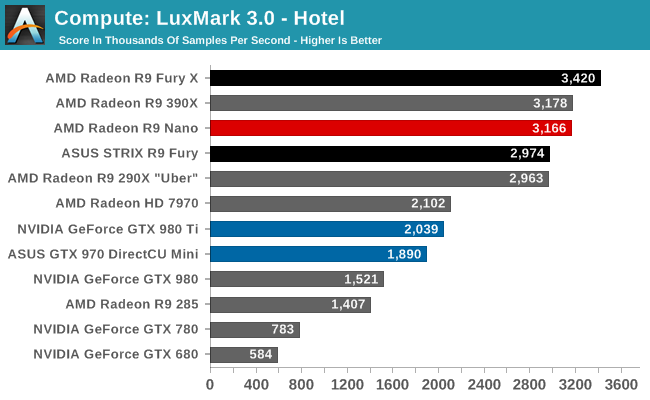
LuxMark ends up being a great corner case for where having a fully enabled Fiji GPU is more important than having the highest clockspeeds. With the R9 Nano able to flirt with its full 1000MHz clockspeed here, the card is able to pass the R9 Fury here. The only thing stopping it from taking the second-place spot is the R9 390X, as Hawaii still sees strong performance here even with fewer SPs.
For our second set of compute benchmarks we have CompuBench 1.5, the successor to CLBenchmark. CompuBench offers a wide array of different practical compute workloads, and we’ve decided to focus on face detection, optical flow modeling, and particle simulations.
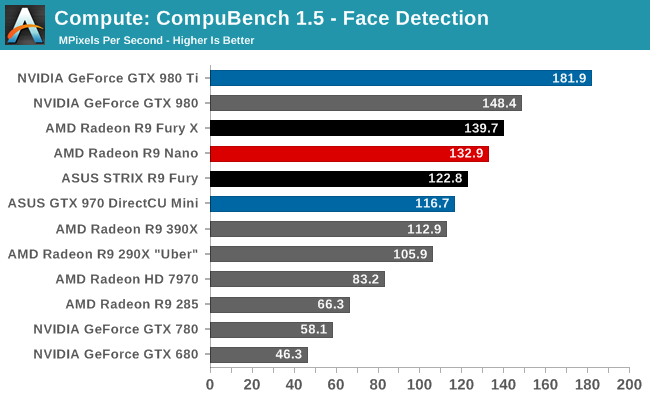
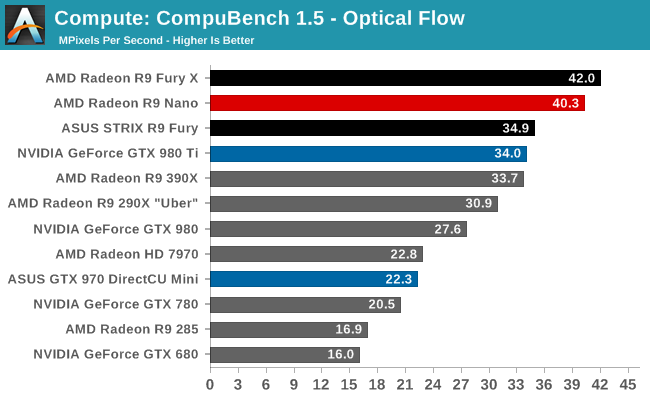
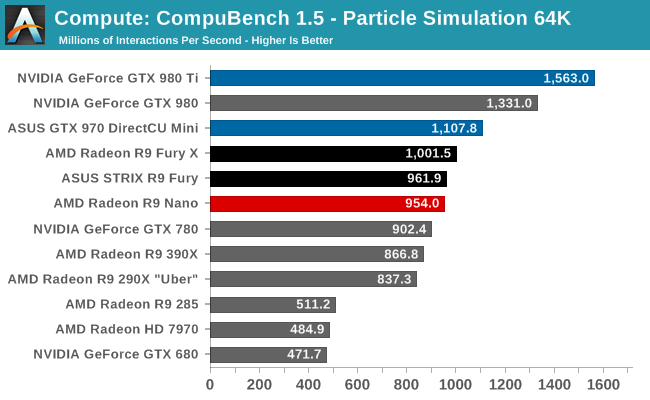
CompuBench provides us another case of where the R9 Nano ends up outpacing the R9 Fury. As a result AMD’s latest card tends to perform somewhere between an R9 Fury and R9 Fury X, with all of the strengths and weaknesses that come from that. This puts the R9 Nano in a good place for Optical Flow, while it will still trail NVIDIA”s best cards under Face Detection and the 64K particle simulation.
Meanwhile it’s interesting to note that AMD’s particle sim scores have significantly improved in the recent drivers. GCN 1.2 cards have seen 20%+ performance improvements here, which may point to some new OpenCL compiler optimizations from AMD.
Our 3rd compute benchmark is Sony Vegas Pro 13, an OpenGL and OpenCL video editing and authoring package. Vegas can use GPUs in a few different ways, the primary uses being to accelerate the video effects and compositing process itself, and in the video encoding step. With video encoding being increasingly offloaded to dedicated DSPs these days we’re focusing on the editing and compositing process, rendering to a low CPU overhead format (XDCAM EX). This specific test comes from Sony, and measures how long it takes to render a video.
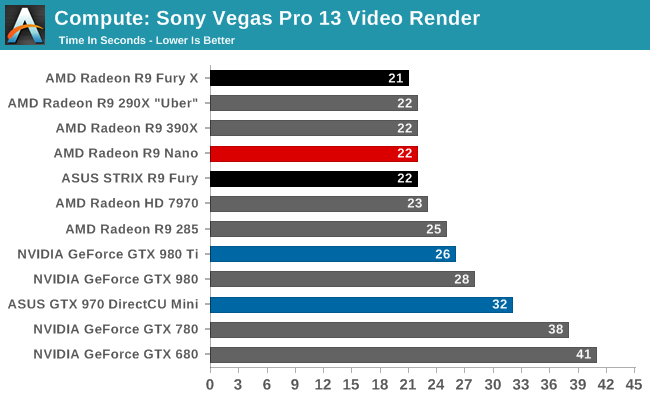
With Vegas there are no surprises; the R9 Nano ties the R9 Fury.
Moving on, our 4th compute benchmark is FAHBench, the official Folding @ Home benchmark. Folding @ Home is the popular Stanford-backed research and distributed computing initiative that has work distributed to millions of volunteer computers over the internet, each of which is responsible for a tiny slice of a protein folding simulation. FAHBench can test both single precision and double precision floating point performance, with single precision being the most useful metric for most consumer cards due to their low double precision performance. Each precision has two modes, explicit and implicit, the difference being whether water atoms are included in the simulation, which adds quite a bit of work and overhead. This is another OpenCL test, utilizing the OpenCL path for FAHCore 17.

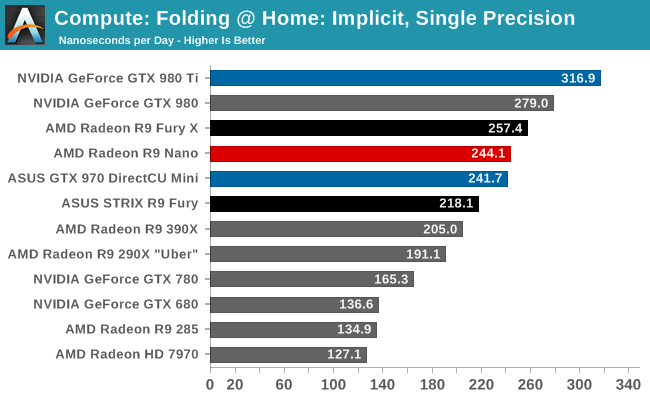
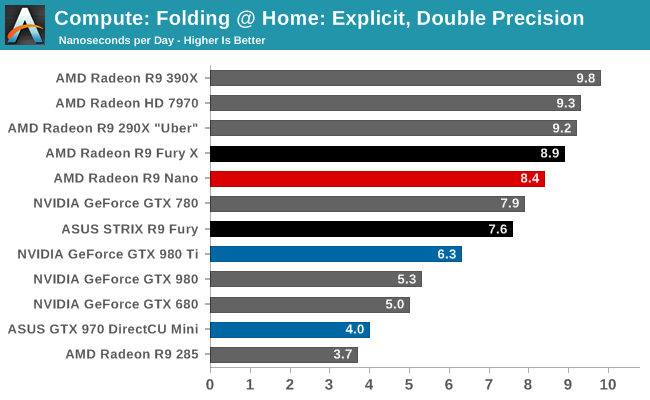
Much like CompuBench and LuxMark, the R9 Nano punches above its weight here. The lack of a graphics workload – and resulting demands on graphics hardware like the ROPs – means most of the card’s power can be allocated to the shaders, allowing higher clockspeeds. This gives the Nano a boost in this situation to bring it much closer to the Fury X, though as far as Folding goes AMD will still trail NVIDIA’s best cards.
Wrapping things up, our final compute benchmark is an in-house project developed by our very own Dr. Ian Cutress. SystemCompute is our first C++ AMP benchmark, utilizing Microsoft’s simple C++ extensions to allow the easy use of GPU computing in C++ programs. SystemCompute in turn is a collection of benchmarks for several different fundamental compute algorithms, with the final score represented in points. DirectCompute is the compute backend for C++ AMP on Windows, so this forms our other DirectCompute test.

Our final test sees the R9 Nano brought back to its place behind the R9 Fury, as the C++ AMP sub-tests are strenuous enough to cause more significant clockspeed throttling. Even behind the R9 Fury the R9 Nano does well for itself here, coming in behind the GTX 980 Ti and head of the R9 390X and GTX 980.










284 Comments
View All Comments
zodiacfml - Saturday, September 12, 2015 - link
Yawnn.. It's not bad till you get to the price. Fury X now has better value as you get watercooling.paravorheim - Saturday, September 12, 2015 - link
"Meanwhile Fury X’s massive power headroom has been significantly curtailed, from a TBP of 275W (and in practice a cap much higher than that) to a much harder TBP limit of 175W for the R9 Nano."You say TBP here, is that supposed to be "TDP"? I saw it in a few other places as well.
SunnyNW - Monday, September 14, 2015 - link
TBP (Thermal Board Power) vs TDP (Thermal Design Power)The0ne - Monday, September 14, 2015 - link
Bin parts for power and cooling efficiency instead of a good design isn't something to rave about. It should be something to write off of because, lets faced it, nothing is different from the previous designs.medi03 - Monday, September 14, 2015 - link
Yeah, "previous designs". Like 290x that beat that day Titan at a fraction of price.Gnomer87 - Tuesday, September 15, 2015 - link
While an improvement in the efficiency segment, this card still loses out to Nvidias alternatives, most notably the older 980. The 980 performs only marginally worse, while having a smaller price tag.It's still a walkover, if I were to replace my hd 7950b today, it'd still be nvidia. This is a problem, if AMD doesn't get their shit together, they're going bankrupt.
And that means monopoly.
Oxford Guy - Tuesday, September 15, 2015 - link
Is there a 980 in this form factor? If not, then it doesn't lose because there is an AMD card that outperforms the 980 for less money as far as I know.IlllI - Tuesday, September 15, 2015 - link
love the nano, can't justify the price. up until now i thought it was going to be $499. the Fury X i can justify the price b/c you can look at it as having a $100 liquid cooler included. but for the nano to be the same price as the Fury X.. I just can't.gw74 - Wednesday, September 16, 2015 - link
AMD_Roy twitter account has been deleted!JonnyDough - Tuesday, September 22, 2015 - link
Wow, lots of crap in the comment's section. I'll post my own. Smaller is better. The trend of hotter, louder, heavier, and more energy guzzling cards was terrible. Not only did it KILL some of my PCI-E slots after awhile from the sheer weight of the card, but most of the old hot running cards are now dead and don't work. It's nice to see a nano card that can fit in an ITX case comfortably. Here's to LAN parties of the future, and more room on/under desks!